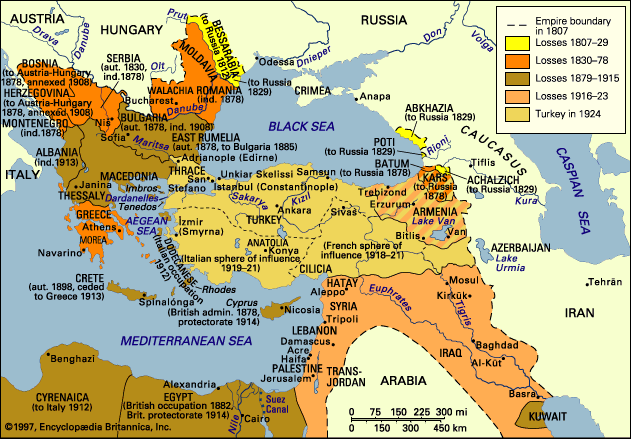Topics in Middle East History
Collapse and Dismemberment of the Ottoman Empire
(Summary of Chapters 18-20)
Copyright ©2016 by T. Pavlidis
NOTE: This summary covers the period from the middle of the 18th century to early 20th century when the Ottoman Empire was loosing a lot of its territory while attempts to reform were futile.
Following the humiliating treaty of Karlowitz (1699) they were attempts to reform the Ottoman Empire but they all failed because of conservative opposition. Thus the Empire was left vulnerable to outside attacks. The Russian were the first to take advantage of the Ottoman weakness and in two wars (1768-1774 and 1787-1792) they grabbed large chunks of territory including the lands on the north shore of the Black Sea. Crimea that had a large Muslim population was supposed to have become an independent khanate but the Russians took it anyway (sounds familiar?). What is now Romania became autonomous and in subsequent years the Russians took over the Ottoman possessions in the Caucasus: Georgia, Armenia, and Azerbaijan.
The 19th century saw revolts in and subsequent independence or autonomy in Egypt, Serbia, Greece, the region around Basra (in modern Iraq), the Arabian peninsula, and several Balkan countries. The Russians attacked again but this time England and France came to the aid of the Ottomans because they had their own designs for its territories.
The map below shows the disintegration of the Ottoman Empire.

The Breakup of the Ottoman Empire.
Source
http://www.britannica.com/bps/media-view/679/0/0/0
One result of the Ottoman policies was that non-Muslims came to dominate the economy and that dominance continued to modern times. Lewis [BL95, pp. 292-293] mentions a list of 40 private bankers in Istanbul in 1912. It included 12 Greeks, 12 Armenians, 8 Jews, and 5 Levantines, people of Western European origin. A similar list of 34 stockbrokers includes 18 Greeks, 6 Jews, 5 Armenians and no Turks. This economic power facilitated the ethnic revolts of the 19th century.
Sultan Abdülhamid II came to the throne in 1876 and acquired the reputation of being once of the most tyrannical sultans even though some people expected him to be liberal. Indeed he offered a constitution and convened a parliament. But a few months later he suspended the constitution and dissolved the parliament. The "reforms" of the previous decades had eliminated all opposition to the sultan so now he had more power than ever before. Of course the "reforms" did little to modernize the army and the Ottoman suffered another disastrous defeat in the 1877-1878 war with the Russians.
One important development of the 19th century was the rise of German (Prussian) influence. Kaiser Wilhelm II visited Istanbul twice during Abdülhamid's reign in 1889 and in 1898, the first Western sovereign to do so. The Germans embarked in a policy of encouraging Panislamism in the hope that Muslim rebellions would dislodge the British from the Middle East. McMeekin's book "The Berlin-Baghdad Express" provides a comprehensive history of such efforts [SM10]. The book is much broader than its title implies. It is better described by the subtitle: "The Ottoman Empire and Germany's Bid for World Power". The narrative starts with Kaiser Wilhelm's first visit that took place just a year after he had become emperor [ibid, pp. 7-10].
In his second visit Kaiser Wilhelm visited Jerusalem on October 29, 1898. He dedicated a German Protestant church but he also take care of the Catholics by sending a telegram to Pope Leo XIII offering his protection of Catholics in the Holy Land. On November 2 he met with Theodor Herzl and made a public statement "Your movement ... is based on a sound, healthy idea. There is room here for everyone ..." [ibid, pp. 12-13]. The Kaiser next visited Damascus where he laid a wreath on the tomb of Saladin and offering to build a marble mausoleum in his honor. He topped it all by declaring in a speech: "May the Sultan (i.e. Abdülhamid) and his 300 million subjects scattered across the earth, who venerate him as their Caliph, be assured that the German Kaiser will be their friend for all time". There were several problems with this declaration: the Shia Muslims of Persia and what is now southern Iraq did not accept the Ottoman sultan as their caliph; and most important, many of the 300 million Muslims were subject of Britain or France. But of course, that was the point for the German Kaiser. He wanted to use Islam to cause trouble for the British and the French [ibid, pp. 14-15].
It was another Drang nach Osten (Push Eastward). The term originally referred to German expansion to the Slavic lands of Eastern Europe, this time the push was in the Ottoman lands and beyond. Pillars of this policy were the German organizers/advisers of the Ottoman army and navy and projects such as the Berlin-Baghdad railroad. The construction of the railroad did not begin until 1903 and only on the flat section from Konya to the Taurus mountains (there were already lines from Berlin to Istanbul and from Istanbul to Konya) but it created a significant German presence in Ottoman lands [ibid, p. 45].
Key point: While the Ottoman Empire was trying but failing to move away from its medieval state, Western Europe was undergoing the Renaissance and the Industrial Revolution. The Middle East (dominated by the Ottoman Empire) missed all that.